Learning To Befriend Winter In Quebec
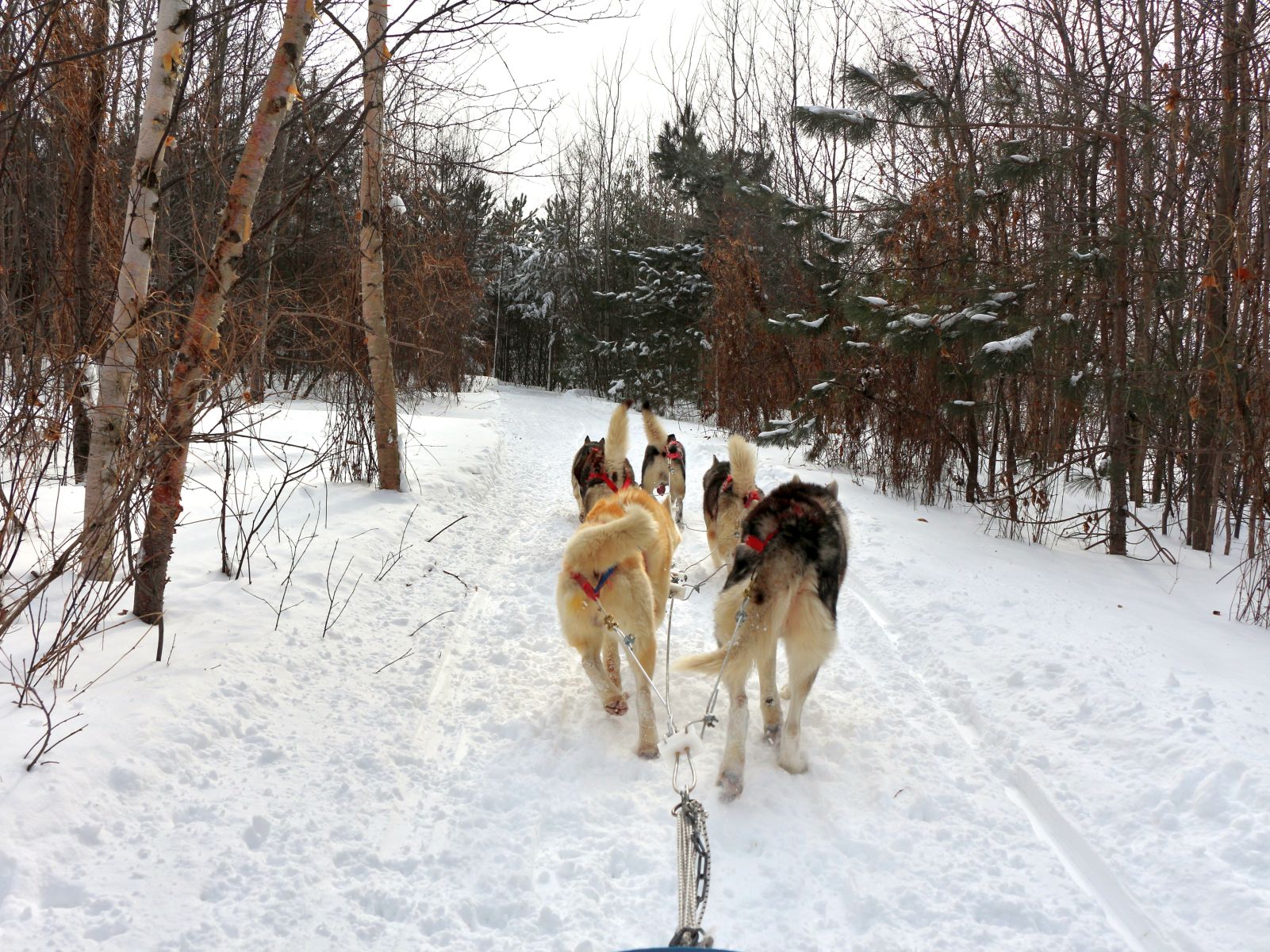
On the narrowest stretch of the trail, hemmed in by forest, Fripouille locked his icy-blue eyes onto me. “Hey, why aren’t we moving?” he seemed to be asking. Not that he could ask me as much. Fripouille (Scoundrel in English) was one of six Alaskan huskies standing in front of me, howling in cacophonic impatience. I gripped the bar of the wooden sled and kept one foot on the brake lever, as I had been instructed by Antoine Simard, the energetic manager and dogsledding trainer of Expédition Mi-Loup on Ile d’Orleans, a few miles downriver from Quebec City.
It was my first time on a dogsled, and I didn’t know how to answer Fripouille, because in this moment, I was also experiencing my first dogsled traffic jam.
Several dogs pulling the sled in front of us had stopped on the side of the trail for a bathroom break. But these dogs were pros at pooping on the run, and had finished before another bark could crack the crisp breeze crossing the island. I lifted my foot off the metal brake. The clanking sound was all Fripouille and company needed to send them trotting, even before my wife, sitting in the sled’s only seat, could shout “allez!” (go!).
And then, gracefulness in motion: six furry tails waving in unison; tongues flapping and steaming. Our faces smacking cold, clean air while traveling fossil fuel-free. No, it wasn’t the Iditarod, but we glided at a comfortable pace that allowed us to absorb views from the trail that first passed through snow-burdened evergreens and then rose up to the island’s naked spine.
And that was part of our plan. My wife and I live in New York City, where we find winter little more than a nuisance of slushy, un-shoveled sidewalks and brusque exchanges — something that just has to be tolerated. We wanted to learn how to look past that limited and unfortunate view of a season. To do that, we had decided to travel to a place where winter is bolder and longer, where winter is not merely tolerated, but also put into one’s service, even embraced.
But first, I had to let an illusion die. I have always wanted to shout a particular word, a syllable that sends muscle into action: mush! The word owes its existence to the peculiar topography of Canada’s bilingual legacy that began with French dogsledders shouting the command marche (“go!”) to their dogs, which became bastardized in English as “mush.” I wanted to feel that history, experience it, pass it on.
Alas, the word has mostly fallen out of use. “It doesn’t matter if you say mush, marche, allez, whatever. The dogs won’t move,” Antoine had told us during our briefing. “The dogs hear the brake release noise as their signal to run.” His buoyancy defied the morning’s chilly gusts, the flaps on his hat up, his beard keeping his face amply warm.
My mushing fantasy had not fallen completely through the ice, however. The word “mush” reentered French, naming the person who drives the dogsled: le musher. In a charming tangle of Canada’s sometimes antagonistic history of language, the word musher is the same in English. This made me a musher, no matter what language I speak.
Fripouille led us back to our launch point outside Auberge Le P’tit Bonheur, an inn that occupies a stone and wood building older than the word musher. Alaskan huskies, their thick fur in the subdued hues of frigid wilderness, distinctly resemble the wolves of their ancestry, but I never knew they were world-class cuddlers. A few strokes along the deep warmness of their neck fur sent them into a nuzzle frenzy, almost knocking me over. An aura of husky musk became our wearable souvenir.
Antoine manages 160 sled dogs and 60 puppies, not one of them named after a real person. Fictional characters, however, remain fair game. When he mentioned that one is named Homer (as in Bart Simpson’s father), I suspected Homer might have been in the back row of our sled team, since he kept pulling to the side of the trail to chomp indulgently on mouthfuls of snow like doughnuts.
The Slow Squeeze
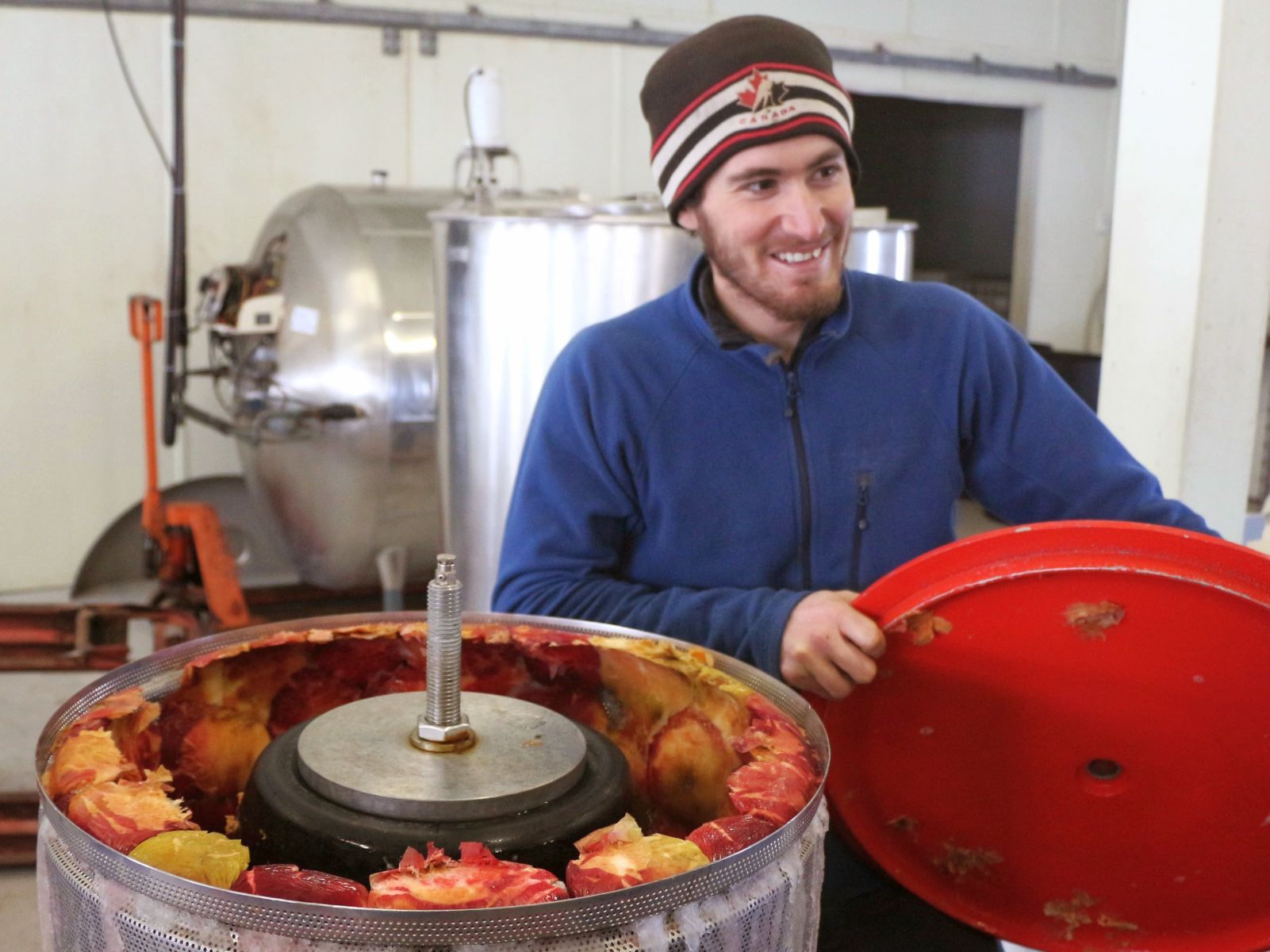
A few days before, we’d traveled to the other side of Ile d’Orleans to visit the orchard of Domaine de la source à Marguerite, where winemaker Conrad Dion offered us a peek at the process of pressing frozen apples to make cidre de glace — ice cider, a specialty of the region.
In the winery’s garage-like workroom, Conrad and his assistant Jean-François, both in rubber boots and knit caps, plugged their fingers in their ears, exaggerating the pose as if a cartoon bomb were about to explode, insuring my wife and I mimicked them. Jean-François opened a valve on top of a cylindrical press, inside of which a thick-walled rubber balloon shot out a fierce hiss, releasing its 50 pounds per square inch of pressure.
Jean-François removed the metal lid from the press to reveal hundreds of flattened apples, still frozen, stuck to the outer wall. The syrupy juice had emerged from tiny holes on the outside of the press, as if it had been sweat out.
Why press the apples frozen? As with pressing frozen grapes to make ice wine, pressing frozen apples produces a concentrated juice because more of the liquid stays behind as ice. The process results in a sweeter, more coveted prize, owing to the higher sugar content, so long as the climate reliably provides a season-long deep freeze.
Jean-François passed me a hydrometer, a device like a pirate’s spyglass. I peeked inside to find a blue line almost off the scale: 34 percent. Was the blue line the sugar percentage? “Oui,” Jean-François answered, his Quebecois accent shaping the word into a casually clipped “weh.”
My wife and I had already been familiar with ice cider’s allure. Four years before we got married on the island and served a case of Domaine Marguerite’s ice cider to our guests during dessert. One of our guests made her particular fondness of the beverage known by announcing, “Ice cider is my new boyfriend!” in front of her boyfriend.
I had imagined I’d hear a percussive concert of shattering frozen fruit during the pressing, but it proved to be much less dramatic. The pressing requires about an hour, depending on the outside temperature where the crates of picked apples are stored. The only sound from the press, aside from its brief wail of sibilance when deflating, was a gentle, therapeutic trickle of thick juice falling into a tray.
The juice would then ferment for six weeks before being bottled. But time is not the only laborious factor. Conrad told us that 80 apples are needed to make one 375 milliliter bottle.
“Quatre-vingt pommes? (eighty apples)?” I asked, insuring my basic French skills hadn’t deceived me.
“Weh, weh.”
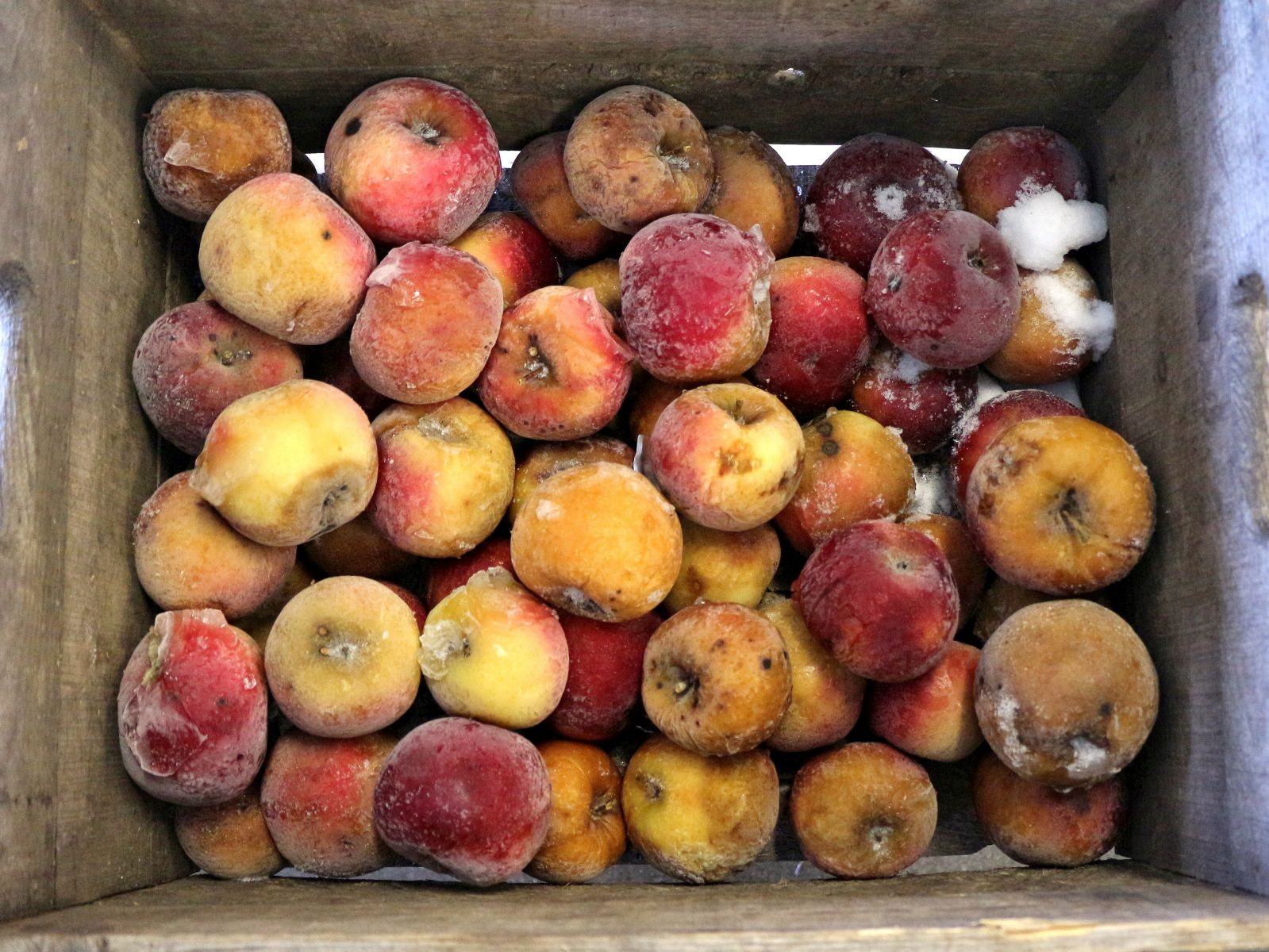
Across the road, a few apples, having turned orange and glistening as if candied, still dangled off bare black branches. “We left a few apples for the birds,” Conrad said. I picked one. It felt as hard as a billiard ball. I reckoned the birds needed ample patience — and strong beaks — to snack on these natural juice pops.
Domaine Marguerite’s ice cider has won numerous awards in competitions held in the Finger Lakes region of neighboring New York State, a feat more admirable considering that Conrad and his wife have only been making ice cider since 2001. But that is a long time in ice cider years. Frozen apples were first pressed in the late 1980s in the southern part of the province, the resulting creation following poutine as another Quebecois culinary invention.
Budding winemakers from milder climates take note: cheating by putting fresh apples in a freezer will fail. Apples must be kept outside to allow air to freely circulate around them, preserving their flavor, that modern flavor of the Quebecois winter, of oenological ingenuity, of boyfriend replacement.
Sleeping with the Moai
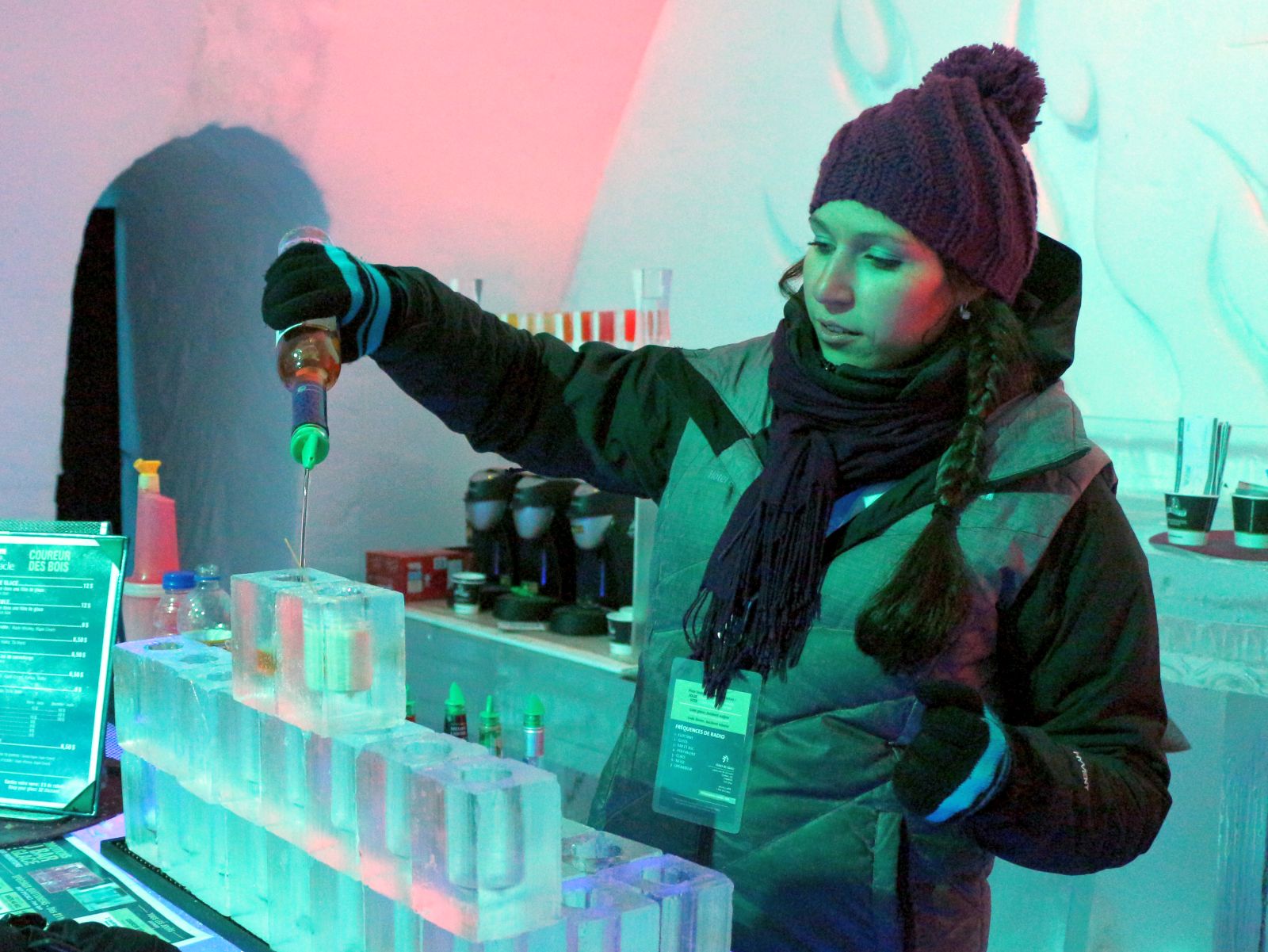
Ice cider appears on drink menus at many restaurants in nearby Quebec City. Flute glasses of ice cider commonly accompany ris de veau (sweetbreads), cheese plates, and crème brûlée. Our next serving of ice cider arrived the following evening at the bar of Quebec City’s Hôtel de Glace, the only ice hotel in the Americas.
Located on the grounds of what used to be a zoo 10 minutes north of Quebec City’s old town, the single-level ice hotel was constructed out of 25,000 tons of snow and ice: vaulted walls, chairs, the bar, everything. That total doesn’t count the daily requirements of the bar that serves drinks in glasses made of ice. Thankfully, I avoided the awkwardness of a Christmas Story moment because alcohol freezes at a temperature lower than water, thus my lips didn’t stick to the glass.
We didn’t stick to the ice pews in the hotel’s non-denominational ice church either. Each pew was draped in a quilt, insulating us from the ice but still allowing the seat to exude a mandatory hardness expected of church seating. With clear ice posts and a packed snow vault reaching over 20 feet high, the ice church seemed to be a place where it was acceptable, even encouraged, to keep the sermons short and sweet.
“We have 40 weddings here each year. We even had one wedding where the groom was a Scotsman who walked down the aisle in traditional Scottish clothing. Know what I mean?” announced our guide Caroline Lafrance from her fur-ringed parka hood. While my half-frozen lips had turned my pronunciation skills into a slur-fest worthy of a wino, Caroline’s speech remained almost flawless, the temperature unable to affect her joke deliveries.
Several of the hotel’s 44 rooms showcased one-of-a-kind sculptures by 15 artists. The Pegasus room featured a 10-foot-high packed snow carving of the winged stallion on a wall. Thick-bodied moai towered over the bed of the Île de Pâques (Easter Island) room.
Two of the rooms featured fireplaces. But guests needed not worry about melted walls collapsing on them as they enjoyed the fireplace’s glow. “They warm your heart, not your body,” Caroline announced. The custom-built fireplaces, though metal-framed — the only metal I’d seen in the ice hotel — are doubly insulated so the heat quickly rises up the vent and out of the hotel, allowing the flame’s gentle flicker, but not its heat, to mesmerize guests.
The construction of an ice hotel could only succeed in an environment that falls under a prolonged deep freeze. All those brief, delicious, spring-like warm-up periods we New Yorkers savor during our winter would spell doom for an ice building. The only melting with which we needed to concern ourselves was known as the rookie’s ring. “Don’t leave your ring on the night table in your room,” Caroline warned. “The ring is warmer than the ice and we will have to chisel it out in the morning.”
In addition to chisels, the hotel’s maintenance crew kept an arsenal of tools specifically suited to ice-based architecture. I occasionally saw a three-man crew passing me in the halls with a wheelbarrow of snow and a couple shovels. I imagined they are the ones tasked with covering the handiwork of snickering couples who have carved their initials into the walls.
We walked to the hotel’s Celsius lounge, a separate, heated building to the side of the hotel, where we stored everything except the clothes we needed for sleeping. We received instruction on how to survive in our room overnight: cotton clothing traps moisture, making you feel cold, thus is your enemy; change your clothes while inside the sleeping bag to prevent heat from escaping; the sleeping bags are rated to -22 degrees Fahrenheit, but the rooms remain at a steady 24 degrees, so you may sleep naked if you wish (the sleeping bags are washed every day).
Ice, especially the custom-made, bubble-free, crystal clear ice used by the ice hotel’s sculptors, would have presented a privacy issue, so the walls were fashioned from packed snow almost a yard thick. The hulky, vaulted shell surrounding us made me feel as if we had hunkered down in the catacombs of a church, or a dungeon turned condo — the ultimate in creative urban renewal — complete with a mattress atop an ice platform.
The experience seemed to straddle the unlikely territory from camping to backpacking to luxury fantasy. But the night’s intense quietness struck me the most. Once zipped up inside the sleeping bag, I heard nothing but the rhythm of our breathing and the occasional chiming crackle from ice forming and melting on the outside of my ski mask, just below my nose.
Along the way, we learned the best way to make a bathroom run, a journey that involved walking to a heated outhouse outside the hotel: quickly.
Cold Enough for a Parade
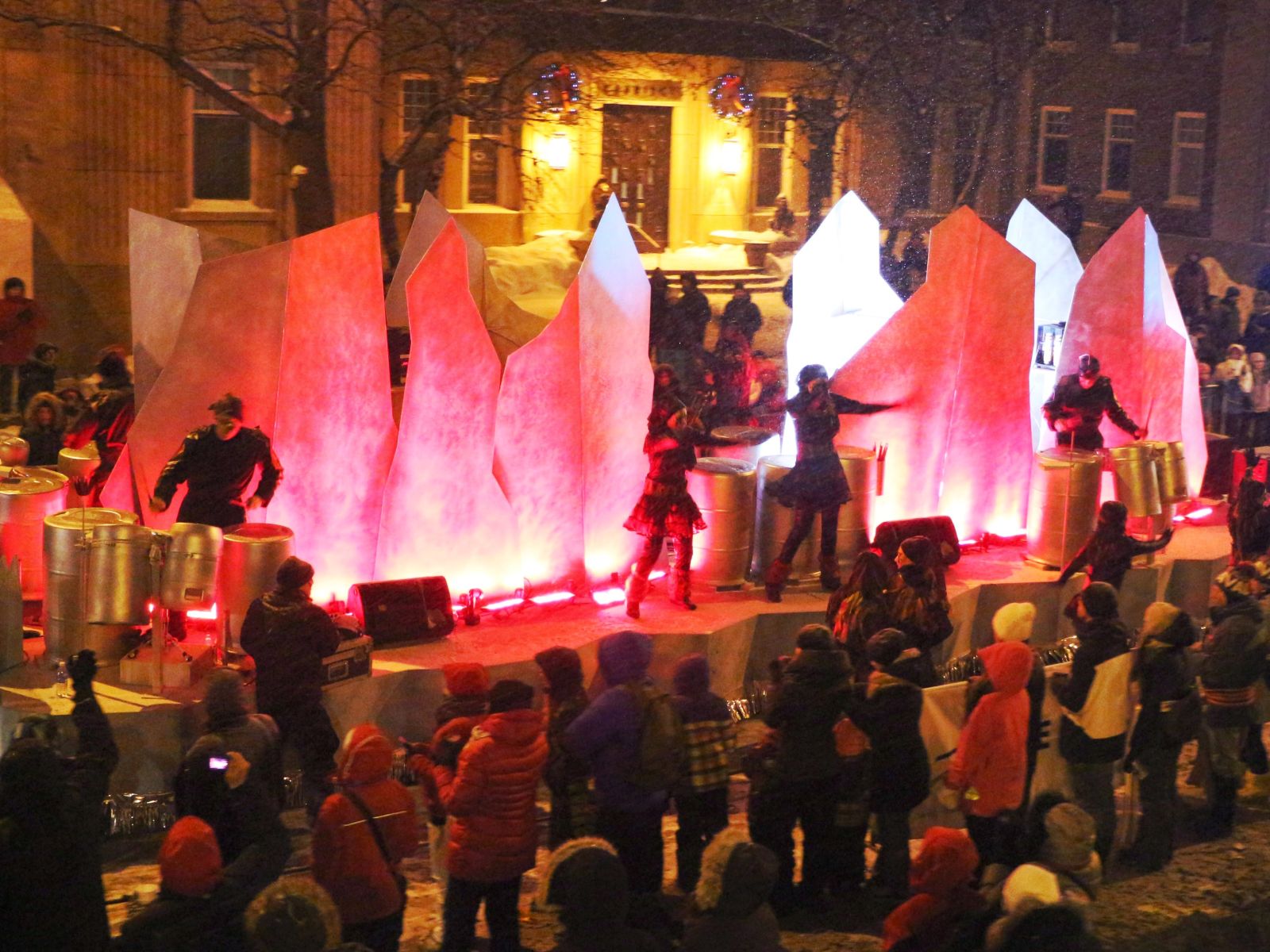
The next night, in the sloping streets of Quebec City’s walled old town, we encountered something that normally fills New Yorkers with dread: snowy, slushy sidewalks. The folks of Quebec City turned the situation to their advantage by pulling along their young ones in sleds, saving the tots the hassle of slipping and falling down.
The residents and storeowners with shovels in hand wore the same crumpled grimaces of snow shovelers everywhere: the “just get it done” face. But in Quebec City, shoveling served to better expose dozens of ice sculptures on the sidewalks, rivaling the ice hotel’s selection. A hockey player in mid-pass, a beaver, a miniature Eiffel Tower, a mannequin modeling a t-shirt — these were just a few of the pieces fronting stores and restaurants, as if a vigorous competition for creating the most enticing sculpture had seized the city.
Quebec City saw no reason to limit itself to a single ice bar. Several nightclubs, including a drag cabaret venue, had built ice bars on the sidewalk, heat-free LED lights illuminating the carved contours of the counters with slowly changing colors.
Just outside the city’s 17-Century fortified wall stood a 30-foot-high ice castle, perhaps taking inspiration from the former. The structure, complete with a jagged parapet, seemed to fulfill a Lego builder’s dream, one where the rare and coveted clear windshield bricks are unlimited.
At night, the temperature sunk to 5 degrees Fahrenheit and gusts of snow were greedily biting at every inch of exposed flesh. What is a city to do when confronted with such climatic challenges? Why, hold a carnival parade, of course.
For Quebec City’s 60th annual carnival celebration, the city closed down the Grande Allee, the city’s widest avenue, for a procession of marching bands (gloves optional), creepy avian-themed stilt-walkers and trailers full of oil-drum percussionists and carnival dancers wearing more clothing than their New Orleans counterparts, but otherwise matching the American city’s delicious dance steps move for move.
Acrobats tumbling onto a float-bound trampoline mocked the temperature with shorts over skin-colored leggings. I noticed that most of the Quebecois stayed put and savored every somersault and tight drumming riff. We remained in the gusts as long as we could stand, but eventually, we wimped out and sat in the provided warming station (a yellow school bus with the heat turned on) for a while.
It looks like our education in embracing winter is not yet complete. I think we might have to return next winter for another lesson.

/
 Darrin DuFord is a travel writer, mapgazer, and jungle rodent connoisseur. He has written for BBC Travel, the San Francisco Chronicle, Roads & Kingdoms, Gastronomica, and Perceptive Travel, among other publications. His work appears in Stories of Music, a multimedia anthology released in November 2015 by Timbre Press. Follow him on Twitter at @darrinduford.
Darrin DuFord is a travel writer, mapgazer, and jungle rodent connoisseur. He has written for BBC Travel, the San Francisco Chronicle, Roads & Kingdoms, Gastronomica, and Perceptive Travel, among other publications. His work appears in Stories of Music, a multimedia anthology released in November 2015 by Timbre Press. Follow him on Twitter at @darrinduford.
